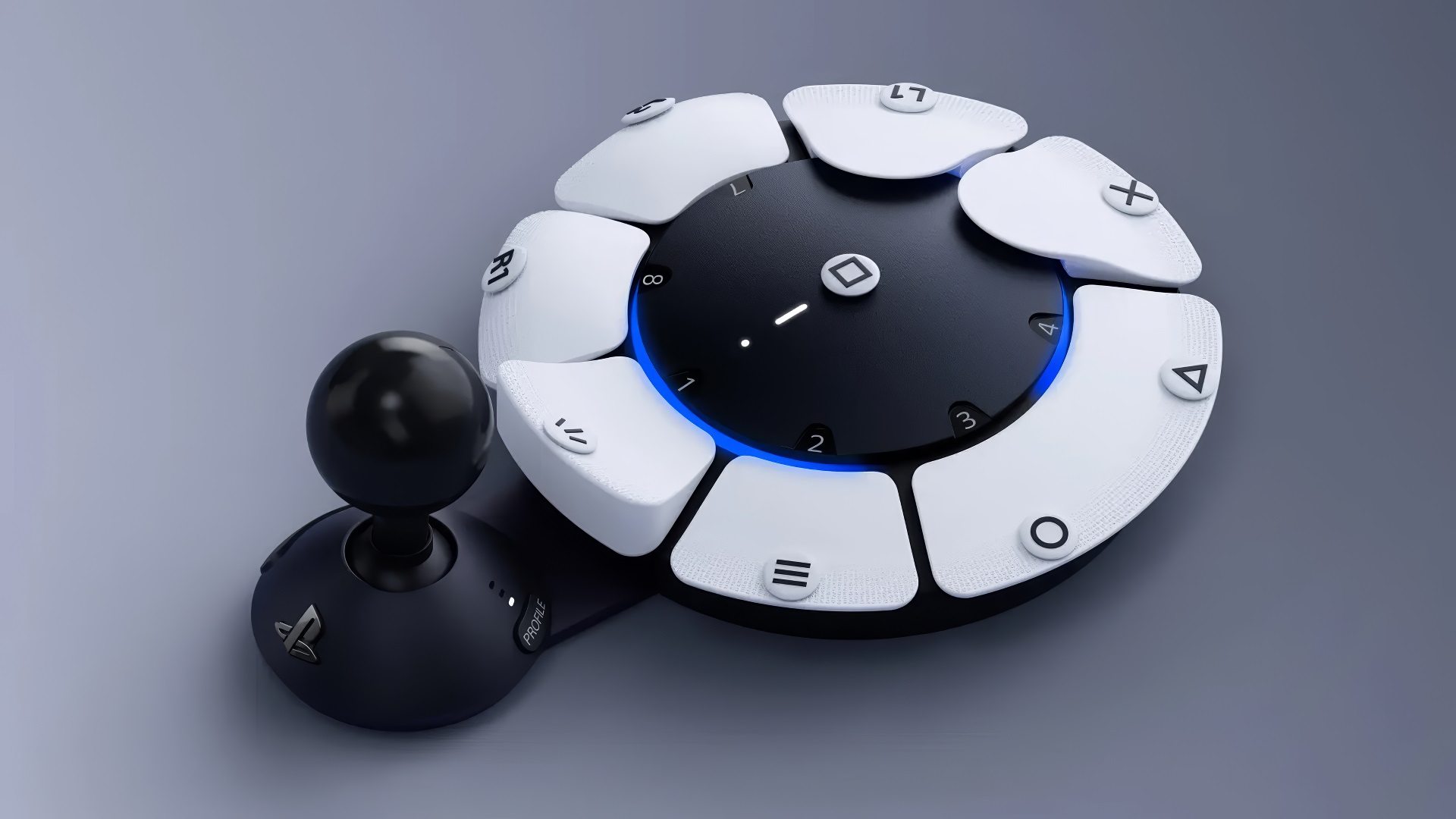Review sample provided by Playstation Spain
Introduction
Since the release of the PS5 console back in November 2020, a big part of the community of gamers with motor disabilities felt a mix of excitement and disappointment. For all the technological advances in visual, audio, processing, and all, one change had a negative impact on a good number of players: the new design of the DualSense controller, which left many unable to play the new titles. This frustration was voiced by many on social media but they never got a fully proper official reply.
Of course, those working on a solution couldn’t talk about it, as these projects take years and secrecy is part of the way most industries work. One can only imagine the stress that these teams experienced during those years they were creating this new device, unable to give hope to the players struggling.
On January 2023, the silence was finally lifted and the first information of the controller was made public under the codename Project Leonardo. The public reaction was very positive and now two questions arose among the community: When will it be available? And how does it work? The latter was due to the particular design, consisting of a circular base with buttons and a lever/stick coming out from one side.
Finally, on July 2023, the official announcement for the controller was published. Along the new name, Access controller, there was a list of specifications, features, pricing and release date: December 6th. A few months later, outlets started to echo new information and details, including an accessory set from Logitech. Playstation published blog posts and videos talking in great depth about the research and design process of the controller, along with videos from the consultants who helped with their insight and lived experiences. People’s expectations had finally got not just a full response but a well deserved solution.
As Ryan Barkataki, UX Researcher from Playstation expressed in this video: “It was incredibly important for us to create an accessible controller as we were really aware of a lot of players in the world who couldn’t use PlayStation for a variety of different reasons. In order to get around this, they, themselves, had modified hardware, used third-party solutions and other ways to be able to interact with it. It was very clear and obvious to us that we needed to do something to sort this problem out.”
The highly anticipated device arrived in people’s hands and reviews from disabled content creators, accessibility specialized publications and mainstream outlets poured in. This here, is ours.
The Controller
First of all, I want to remind the reader that my subjective experiences might be vastly different to yours. I have Spinal Muscular Atrophy Type 3 in a very advanced state, and the strength and capability to move my arms is limited. I can only make functional use of my right arm and hand at a limited capacity and my left arm is almost null. Please remember this.
Unboxing
The first thing I want to mention is that the opening of the box is designed to be easily done by pulling from a piece of cardboard with a loop on it. The hole serves to insert your finger or any hand tool you would normally use. I just used my finger to grasp the piece and with a few pulls it came out. Accessible boxing is very important as it increases the level of independence of the user, and I think we all can agree there is a sense of satisfaction when you open something you just got.
After that you have similar style of pull loops for the cover and rest of compartments inside the box where buttons, sticks and signs are placed. Also, none of the components are wrapped in plastic or anything, just covered with thin sheets of protective material to make the whole process more accessible.
Unfortunately, for me that is where this process ended, as the controller’s weight of around 330 grams made it impossible for me to pull it out of the box. With assistance, I placed the controller on the keyboard trail I use for all my peripherals and plugged the Access controller to the console in the frontal USB port to charge the battery and set it up for the first time. After the device has been properly configured it can work wirelessly so you can remove the cable.
Before I describe this process, let’s look at the device itself.
Physical characteristics
The device is formed by a stick and a circular base where the buttons and connectors reside.
The Stick
The stick is surprisingly soft and easy to move in all directions. By default, it comes with the dome cap preinstalled, but the customization set of pieces in the box also include a smaller circular cap, similar to the one regular sticks use, and a sphere shaped cap. This spherical one also has a greater lever length. After trying the three of them I found that the longer stick required less strength to push it which was a good feature and the spherical shaped cap allowed me to reach from farther and have a better grip when using your full palm on it. It feels like the classic arcade sticks but much easier to move. On the other hand the extra height caused me to have my hand in a position that caused discomfort on my wrists, so I went back to the dome cap which offered me a better balance.
An interesting and useful feature is the possibility to finely adjust the distance between the stick and the base. This helps greatly to accommodate your hand and reach the buttons better, depending on your needs. To do this you need to press a button on the base of the stick, which will unlock it. Once you find the right position, you have to press it again to lock the stick. I measured the distance from the stick to the center of the buttons at minimum and maximum extended distance. Please note that these are approximate values.

At the minimum distance from the base:
- To the closest button: 3 centimeters
- To the central button: 9 centimeters
- To the more distant button: 15 centimeters


At the maximum distance from the base:
- To the closest button: 6 centimeters
- To the central button: 12 centimeters
- To the more distant button: 18 centimeters
Finally, the stick includes a button to switch profiles, the usual PS button and a button when pressing down the cap. Unfortunately, all these buttons required too much pressure for me to use by myself. Regarding the Profile button, you can store 3 profiles on the device, and pressing this button will switch from one to the next. Unfortunately, this button’s position and stiffness make it extremely difficult for me to press. We’ll see why this mattered later, in the Personal Experience section.
The Base
The base is circular and on the top side of it we find 8 buttons around the edges and a big The buttonsdifferent shapes, except the central one.
The process to remove the caps is simple. Insert your finger under the button’s external edge, push slightly in and upwards and it comes off. Replacing the buttons is even simpler, just position it properly, press down and it will latch into place as the caps are magnetic. In my case I could change a few of them myself but not all as the different shapes influenced how well I could grab them.
The default button shape is bumpy with a texturized surface. These are referred to as “Pillow” caps. These are all the shapes that are included:


8 Pillow button caps: The default ones. Slightly bumpy and texturized.
4 Flat button caps: Same shape and size as Pillow but without the height and texture.
4 Curve button caps: Their interior side is lower and ascends near the exterior, like a ramp. Texturized edges.
2 Overhang button caps: Like Flat buttons but longer, reaching well into the center of the base.
1 Wide flat button cap: A flat, non-texturized button cap that can be used to press two buttons simultaneously or be used as a bigger surface button if you disable one of the inputs. Disable both and can be used as a wrist rest.
It is impossible to explain what buttons work best because that is something extremely personal. The good thing and a key aspect of the controller’s design is precisely this variety of options to adjust it to the player’s needs and preferences. I am using a mix of 4 Pillow and 4 Curve, as the height helps me press the buttons. It is worth noting that I can only comfortably press 6 of them, including the middle one. The others are in a position my hand mobility won’t allow me to. I reach them with my ring and pinky finger but lack the strength to push them. Buttons aren’t too stiff but pressing them requires a good amount of pressure. I wish the buttons were slightly softer, but I understand that might cause accidental presses. I hope in a future iteration the amount of strength required can be adjusted.
The base won’t slide with ease for me but in case you want to secure to a wheelchair or other standardized supports, you can do it with screws that can be mounted at the bottom of the base.
Finally, the base has a USB C connector for initial setup, battery charge or connecting to a PC. There also 4 3.5 millimeter ports to connect external devices such as switches or joysticks. There is no audio jack. Considering that a regular DualSense has 2 sticks, 14 buttons, a D-Pad, and a touchpad, the user will need switches if they want to have access to the same number of buttons.
Unfortunately, the lack of touchpad and d-pad can be an issue. On the positive side, the profiles and system button remapping can help with the D-Pad issue. Still, 4 3.5 millimeter inputs is quite insufficient. It is clear the device was designed to be used in conjunction with a DualSense controller, and for those who can’t do it like me, that is a serious problem. Using it with another Access controller could help to have a complete set of controls, with two sticks and plenty of buttons. I tried but it didn’t work well for me as I am basically a one handed user. If this is not your case, your options will open up to new possibilities and most likely to a much better experience.
Software
Upon connecting the controller for the first time, a setup process begins. It is extremely clear and easy to follow thanks to its well-paced design with little amount of text in each screen and visual illustrations to complement the explanations. Worth mentioning that during this process the console screen reader works perfectly, in case you need it.
During this process you set up your controller orientation, indicating where you are positioning your stick. This way the device will accommodate and during remapping and more, you will have an exact visual representation of your setup. More importantly, this allows the controller to know exactly where your stick inputs (forward, backward, left and right) should be placed. Also, you can customize your stick sensitivity and deadzone, allowing you to fine tune your movements to push less or more the stick. I have my stick positioned to the left and I increased the sensitivity a bit, but if you need more you have room for it, saving strength and helping reduce fatigue.
Finally, you can map your inputs so each button will perform the press that you want. I moved the most common inputs such as the face buttons and L1 and R1 to those I can press more easily. Others that could result in issues, like the Circle button I set on the others.
Another great functionality is that remapping allows to set buttons as toggles, meaning that with one single press it will act as it the button was held down, and with a another single press it will be released. For games requiring holds this helps immensely to avoid barriers and save energy. Less energy wasted holding buttons equals to more energy for actually enjoying the game.
The last functionality worth mentioning is that you can assign two simultaneous inputs to a single button press. This is very useful for games that require you to push two buttons at once to perform an action but you physically can’t. Now you assign that here and it’s solved, at the cost of losing one button.
Personal experience


It has taken me quite some time to adapt and still I face problems in games that require using more than 6 buttons or two sticks all the time. My first idea was to create profiles with the same button inputs but alternating the stick functionality from Left to Right. Similarly, I switched the functions of the main buttons to D-Pad inputs, L3, R3, Create and Menu. On paper it was a way, but the impossibility to switch profiles due to the Profile button issues mentioned before made it unusable. Using external switch buttons didn’t help either as I had to reposition my hand all the time to reach them.
In the end I must play only games that don’t require more than one stick, no more than 6-7 buttons buttons, no touchpad or D-Pad and have simplified controls and other accessibility features. For example, a game like The Crew Motorfest wasn’t just playable but highly enjoyable. Driving with the stick and a couple of buttons was very comfortable and got to experience the game at its best. Others that required more buttons or camera movement were a struggle, and had to stop playing due to frustration and tiredness. This is far from ideal, but still, it’s better than nothing and at least now I have a way o play some games on a new platform.
It’s important to understand that there isn’t a single solution or device that will work for everyone. The Access controller offers certain level of customization, a good stick, powerful software and more, but it also requires a certain level of strength, specially if you can only use one hand, and the capability to reposition your hand easily to combine it with switches. Another alternative would be using switches with your feet, head or other parts of your body. This might sound disheartening but it’s a reality, my reality in this case. Yours will depend on whether these issues apply to you or not.
Still, I want to praise Sony for creating a device that has a good amount of customization and features that are undoubtedly helping lots of people have access to their experiences on PS5. Now all that is left is an app for the device that allows the same level of customization on PC, where the controller works only partially through the Steam remapping feature. With Sony’s recent and increasing presence on the PC platform this would be a huge opportunity to extend the use of this device to many more players that need it.
BEST FEATURES
- High quality stick.
- Customizable stick and button placement.
- Stick and button shape customization.
- Powerful software to improve the experience.
- Simple setup process with good explanations.
- Accessible boxing.
NEEDS IMPROVEMENT
- Buttons on stick can be hard to reach and press.
- No customization for button pressure.
- Lack of touchpad support.
- Few buttons and switch ports.


Antonio I. Martinez has Spinal Muscular Atrophy Type 3 and has been a gamer for most of his life. His background formation in computer programming and English compose his basic skill set. Previously mobility editor for Can I Play That, founded this new project to inform other fellow gamers and offer actionable feedback. As consultant, his work includes publishers like Xbox, Ubisoft and Rebellion. Beyond self-advocacy, he’s done webinars, talks and participated in many interviews on different media channels to educate about the importance of accessibility in games. Judge for The Game Awards and the AGDAs. You can contact him on Twitter/X at @Black1976
Gaming Center
Gaming center adalah sebuah tempat atau fasilitas yang menyediakan berbagai perangkat dan layanan untuk bermain video game, baik di PC, konsol, maupun mesin arcade. Gaming center ini bisa dikunjungi oleh siapa saja yang ingin bermain game secara individu atau bersama teman-teman. Beberapa gaming center juga sering digunakan sebagai lokasi turnamen game atau esports.



